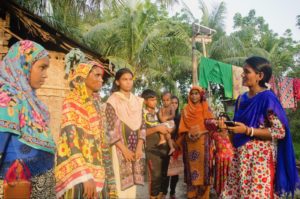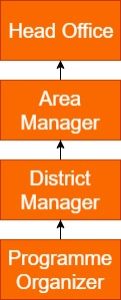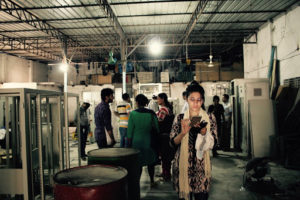
Search
When applied to organizational management, the term “top-down” can suggest the image of an inflexible boss dictating policy and tasks to subordinates rather than motivating and encouraging team members to let their good ideas rise from the “bottom-up.” It has a very different meaning, however, we describing data collection methods.
When building and scaling a field data collection and analysis system, a “top-down” approach is no better or worse than a “bottom-up” strategy but rather one of two data collection methods used to accomplish the same goal – aggregating and analyzing field data to inform business decisions.
Both of these data collection methods have their pros and cons in terms of optimization and scalability so let’s look at how both were used by the BRAC Skills Development Programme (SDP) – highlighting the failures and successes of each approach and how TaroWorks’ field service management app facilitated the work.

Image: TaroWorks being used on a smartphone at an SDP learner’s house. Source: BRAC
At the beginning of SDP’s data collection and analysis effort, a simple Excel spreadsheet – using the Visual Basic for Applications programming language – was designed by BRAC SDP for Programme Organizers (PO) – essentially the people working in the field – to gather and input data. POs used to collect data and record it by pen and paper before entering the information into the spreadsheet. They would then send the compiled information file to their District Manager (DM). Each DM would supervise six POs and they in turn would be supervised by an Area Manager (AM) who handled three DMs at a time. DMs would compile six reports and send them to the AM who would then have to compile the eighteen reports coming in from various regional DMs into a final report that would be sent to the Head Office (HO).
To mitigate problems of using spreadsheets, a new data collection and analysis method was conceived and deployed using a bottom-up approach to system design. Trainers from BRAC SDP trained POs in the use of TaroWorks’ mobile offline data collection app, which uploaded results to a Salesforce.com cloud database for analysis by District Managers, Area Managers above them and then finally by the Head Office. The data collection was possible without the internet using TaroWorks as it would store the data locally and later upload the information to the Salesforce cloud database when a mobile data or wifi connection was available. The whole system was designed to be user-friendly for POs.

Bottom-Up Data Collection Design. Source: BRAC
We wondered if the first two problems, however, might be program-specific and concluded they were after completing a similar data collection and analysis project in Satkhira, Bangladesh. This separate and subsequent project was called “Livelihood Skills Training for Out of School Children in Satkhira & Khulna” and was funded by UNICEF. It utilized the same bottom-up approach in 32 different branches in the region. As the project was concentrated on a particular area, the data was able to provide insight into trends and the model proved to be adequate for the purpose.
The POs were strictly instructed to not use any paper for data collection and recording for the Satkhira project. A survey among the POs found that 70% of them already had smartphones and the remaining 30% were encouraged to buy them by offering monthly stipends for the devices. As a result, the first two problems listed above as issues in the bottom-up approach were less prevalent in this group.
The third problem, however, involved the very nature of bottom-up approaches and that led the BRAC SDP to try out a second of two data collection methods – top-down approach – as a potential alternative design for data collection and analysis work.
Here HO staff first trained AMs and then DMs (staff at the top of the organizational structure) who later went on and trained their POs – the front line field teams. This approach involved using Google Forms as the primary data gathering tool. Surveys were prepared using that software and sent out to all POs in 117 branches. Graphs and charts created from the data collected with Google Forms were introduced for DMs and AMs to help sort data and make reports. As the data involved less text-based responses reports were relatively easy to create.
After experimenting with both bottom-up and top-down data collection methods, BRAC SDP had to select the favored approach going forward as we expanded data collection and analysis efforts to an additional 135 new branches. As it was observed that the top-down approach was more beneficial when dealing with projects of larger size, BRAC SDP opted to go for that model as we scaled-up. A bottom-up approach has its merits but only when it is used for small or pilot projects.
Given its features like offline data collection and field force management, TaroWorks was adopted for the expanded top-down approach as well. The BRAC SDP staff who had used TaroWorks in the bottom-up test became a resource to help train BRAC team members who had previously used Google Forms.
Given what we’d learned along the way, improvements were also made to our design and implementation of the expanded top-down program.

Image: Light engineering factory in Tongi. Source: BRAC/Farzana Trina Chowdhury
All the system design in the world won’t benefit your data collection and analysis efforts if you don’t also have a clear sense of what you’d like to use the data for and how it will offer both business insights and help drive a data culture in your organization.
Here are two examples of how the data we’ve collected using the top-down data collection method is being used at BRAC to foster continuous improvement of business operations and has helped us emphasize the importance of data in our organization.
Many TaroWorks customers previously used paper and spreadsheets to collect data, analyze metrics and run field operations. Let us show you how TaroWorks’ offline mobile field service app can help scale your business by digitizing sales and supply chain management, increasing agent network productivity and analyzing data in real-time for business insights.
POST TOPICS
Sign up to receive emails with TaroWorks news, industry trends and best practices.
TaroWorks, a Grameen Foundation company.
Site by V+V